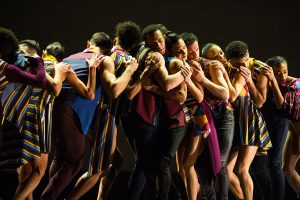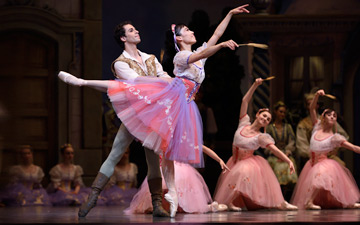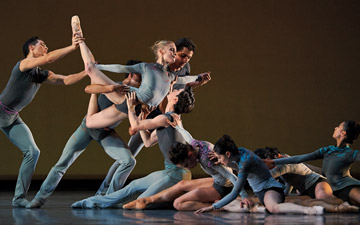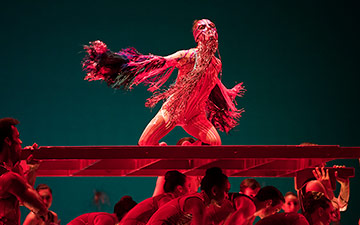
© Benjamin Hersh. (Click image for larger version)
Katharine Hawthorne
Mainframe
San Francisco, ODC Theater
3 Dec 2015
www.khawthorne.net
odctheater.org
Vintage Macintosh computers play a central role in Mainframe, a new evening-length dance-theater work by San Francisco choreographer Katherine Hawthorne. The show has the gorgeous production values of an Apple commercial. Unfortunately, it lacks the adman’s disciplined editing.
Hawthorne has been exploring the connections between science and dance since she earned her degrees in physics and dance at Stanford University. Stanford’s culture is immersed in computers and technology – think Sergei Brin, Larry Page and Marissa Mayer – so it’s no surprise that Hawthorne would create a contemporary dance work about the effect computers have on human minds and movement.
Mainframe starts strong, with two men and two women doing syncopated floor work and jagged arm movements behind a blurring scrim – the theatrical equivalent of bits and bytes booting up a computer. Such clever riffs abound: a Q&A between the dancers and Siri (the voice of Apple’s iPhone) drew genuine laughs, while a reprise by Suzette Sagisi and Megan Wright juxtaposed the living, breathing warmth that we lose by relating most closely to our devices.

© Benjamin Hersh. (Click image for larger version)
Hawthorne also created an original vocabulary for Mainframe, with bent-to-the-front arms, pointed hands swiping overhead, elbows swinging out horizontally, floor rolls and hop steps. There’s a delightful revelation when a synthesized computer voice reveals the corresponding commands: keyboard, click and drag, space bar, crash, reboot. The dancers repeat the steps faster and faster until they’re reduced to twitching remnants of human beings. The machines have risen.
The dancers willingly submit, but with most movements kept small, we got only a few glimpses of what they can really do. Sagisi’s asymmetrical one-legged balances on relevé had me on the edge of my seat, and Katherine Disenhof unleashed dynamos in her solo appearances. Wright boasts lovely ballet lines and notable comedic chops, while modernists Gary Champi and Gabriel Mata brought a hop-hop sensibility to jerky arm gestures, inversions and pliés.
The dancers are beautifully aided by David Robertson’s lighting design, with stacks of amber bulbs, floor-level uplights and overhead spots playing dynamic roles on all sides. Along with David Flynn’s composition “A Future,” the score includes sounds by Matt Parker, a Ph.D. candidate in Creative Research in Sound Art Practice at London College of Communication, who artfully integrated electronica with startup beeps, modem screeches and keyboard clicks. Sterling King’s deconstructed tunics are perfectly futuristic.

© Benjamin Hersh. (Click image for larger version)
Ironically, though, for all this whizbangery, Mainframe feels behind the times. After the scrim falls, Gary Champi dances a pas de deux with a Mac, crawling towards it, staring quizzically, gingerly reaching a finger out to touch it and quickly drawing back. It’s a familiar set of gestures, and without segueing into a more complex relationship between man and machine, the wonderment starts to feel forced.
A nonplussed air continues throughout, with perplexed facial expressions and hesitant body language suggesting that the most problematic interface is confusion about what happens when you push the power button. A wide-eyed sequence set to Beethoven’s Piano Sonata No. 1 has a Keystone Kops feel that would work beautifully in a farce but feels at odds here. Later ensemble and duet sequences seem inserted for their own sake – fine to watch, but unclear in their purpose.
Hawthorne has a compelling idea, but in a high-concept piece like Mainframe, every creative choice needs to raise the stakes and narrow the focus from beginning to end. Some judicious editing and a bit of reprogramming would free Mainframe from its infinite loop.

















You must be logged in to post a comment.